Fractal BugFest, future of learning, math storytelling: Newsletter October 6, 2014
Subscribe and read archives
Pinterest | Twitter | Facebook | Google+
Hi, I am Moby and I bring you the news about Natural Math. Send me your questions, comments, and stories of math adventures at moby@moebiusnoodles.com

In this newsletter:
- Math coloring pages and other activities to try
- Math Future live online meetings for teachers, parents, and teens
- Math Storytelling Day stories
Math coloring pages and other activities to try

BugFest is a big annual celebration of insects and crustaceans at the North Carolina Museum of Natural Sciences, attracting some 35,000 visitors to its hands-on learning centers – for example, to explore fractals in nature at our table. We miss you already, BugFest friends, and hope to see you again next year! Huge thanks go to the amazing kids who liked our activities so much that they taught them to others. The two most popular activities at the BugFest were insect-themed coloring pages and origami.
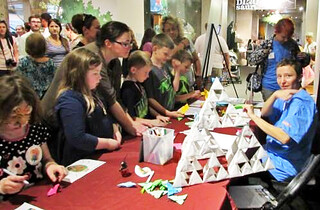
The youngest math explorers and people of all ages who like art can color the Sierpinski butterfly and the Droste beetle, named after the fractal designs on their wings. Or you can design your own fractal fantasy creatures, as visitors did at our table.
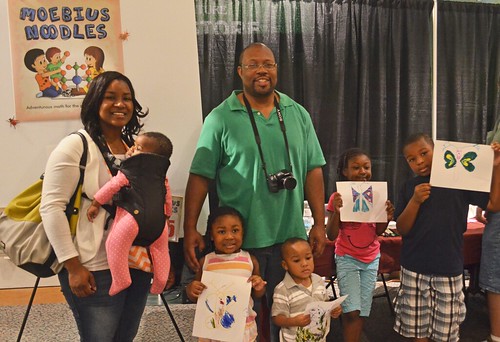
Kids develop their intuitions of exponents and infinity with these easy but complex designs. Click to print a larger picture:
Some visitors wanted to go beyond the flat, 2-dimensional drawings – 1.58-dimensional, to be more precise, in the case of that Sierpinski butterfly. We invited them to fold origami butterflies. As a craft, origami develops several precious mathematical practices directly useful for geometric construction, topology, integration, and analysis of functions – and indirectly for all of math:
- Making shapes out of shapes, and seeing shapes within shapes
- Precision and accuracy
- Reasoning between flat, 2-dimensional medium (paper) and 3-dimensional shapes made out of it
- Decoding words, symbols, and visuals from directions into the kinesthetic experience of folding
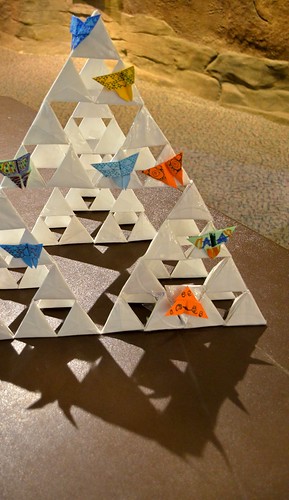
Here are origami symbol and video instructions similar to the butterflies we folded. We skipped shaping the wings at the end (step 10) to make folding easier for the little fingers. Simplifying other people’s patterns is an easy way to start remixing your own origami designs.
This year, FIRST LEGO League world class challenge is, “What is the future of learning?” Two local teams invited Maria Droujkova to talk with them about learning – and once again, she invited kids to fold paper, airplanes this time. The first fold of the paper, just in half, can be explained with just words. As you build the airplane and the folds get more difficult, you have to show the folds, not just tell about them. Toward the very end, you must add the kinesthetic mode of learning to words and visuals. You and your student hold the project together; you guide the folds, so your student can feel how the fold must go. The future of learning is in making your own math – and in using all your senses as you do so.
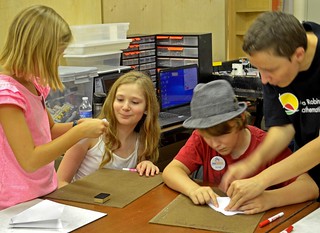
We also came to a playdate with a local parent group called Wee Play. We met the kids and parents at a park, did a Math Trek scavenger hunt, drew some fractals, and made mandalas out of found materials.
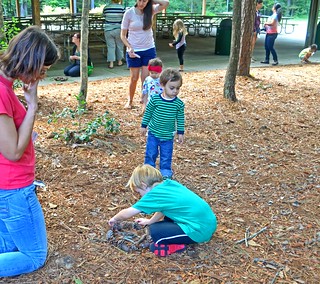
All these activities help to grow your math eyes so you notice mathematics everywhere you go. If you’d like to try a Math Trek, choose a place you like and look for the items listed on the Trek Clue Card (click to get the PDF with 4 copies). Once you find the item, don’t forget to take a picture. You can always share the pictures with us via e-mail, on your blog mentioning Natural Math, or by tagging @NaturalMath on Twitter.
Another big September event was SparkCON, where Maria Droujkova presented a PechaKucha talk called 5 Year Olds Can Learn Calculus. It is a sign of a good connection with the audience when people come up to Maria afterwards and share their math stories – often grief stories: “Let me tell you what happened to me in the third grade!” You can watch the (homemade) video of the talk or look at the slides and the text.
If you would like to invite the Natural Math crew for your events, big or small, write moby@moebiusnoodles.com
For teachers, parents, and teens: Math Future live online events
Math Future is an international network of people who care about mathematics education: researchers, developers, teachers, parents, and students. Since 2009, we have organized more than a hundred live online events with leaders of amazing projects.
On Monday, October 6, at 1 PM Eastern Time, Dr. Keith Still of SaferCrowds.com will introduce his Crowd Sciences work. Learn more and register.
On Wednesday, November 5, at noon Eastern Time, Dr. Joseph Mazur will talk about his new book, Enlightening Symbols. Learn more and register.
Come and listen to short presentations, chat with like-minded people in the audience, and pose questions for presenters!
Math Storytelling Day stories
September 25 was the Math Storytelling Day – thank you for all the stories you sent! Check out these people and groups who joined the fun.
- The Hospital Floor. Denise Gaskins the brave, of Let’s Play Math, shares her thoughts about a semi-random tile wall in her hospital room where she landed with appendicitis.
- Crafting Stories is Juliana Lee’s blog about, well, stories, and she celebrates by reviewing three excellent children’s math readers.
- Bradenton Herald, a Florida newspaper, included Math Storytelling Day in an article by Stephanie Katz about absurd observances, in the excellent company of Talk Like A Pirate Day, our second-favorite September holiday. Arrr! (The official Pirate language page says it means “I am happy.”)
- The Upside Down Triangle author thinks Math Storytelling Day is the best holiday of the year – and posts one of my favorite animated math stories ever, The Cyberchase, to celebrate.
- 4 The Love of Math, a very prettily patterned, pastel-colored blog of Randi Loveland, posts a mini-guide to nerd t-shirts, so you can celebrate in style.
- Awkward Silence Comedy had an improv event staged, described thus: “ASC rides a Mobius strip to the moon! It’s Math Storytelling Day and you know what that means! Bust out those anecdotes about infinite hotels, sketch out some knots, remember that time that grandma forgot to carry the 1. Good times with Grandma, indeed.”
- Math Road Trip Project is a homework assignment that structures a math story around a road trip. How many calculations can you include before your story turns into a non-magical pumpkin, that is, a story problem? Try it and find out!
- Sequence Story Competition was held at Furness Academy, Cumbria, UK. Their intro video has several prompts for writing stories.
This week, we are producing and sending the official Math Maker t-shirts for everybody who ordered or won them. Don’t wait for Math Storytelling Day 2015 to share your story. You can send us a tale of your math adventures any day of the year!
Sharing
You are welcome to share this newsletter online or in print.
Talk to you soon! Moby Snoodles, aka Dr. Maria Droujkova
Related Posts
Posted in Newsletter


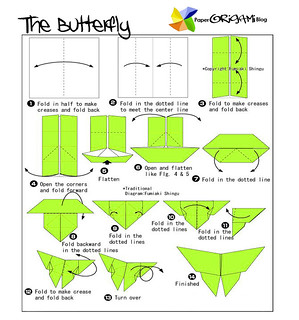
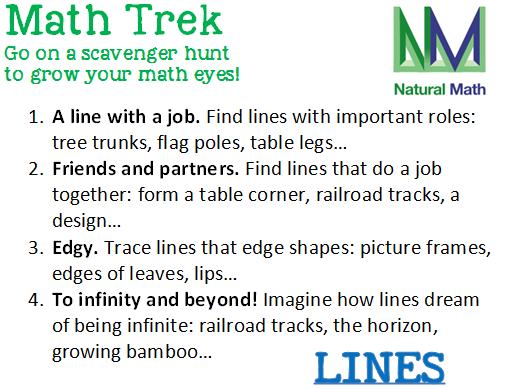





Leave a Reply